Omnity REE

REE (Runes Exchange Environment), by Omnity Network, is a decentralized execution layer for Bitcoin DeFi. It enables open and composable smart contracts to deal with bitcoin assets directly, without relying on bridging, asset wrapping, or non-bitcoin wallets. Unlike traditional bitcoin layer 2 solutions, REE preserves bitcoin’s security while enhancing programmability through turing-complete smart contracts, all while maintaining native bitcoin transactions and a seamless user experience. RichSwap, a Runes DEX that allows multiple operations in a single bitcoin block, and Tyche, a token launchpad, are two examples of applications built on REE.
REE is the second Bitcoin infrastructure product built by Omnity Network. Omnity Hub, a bridge connecting multiple Bitcoin layer 2 blockchains to other blockchains like SUI, Solana and Base, has achieved over $120M in TVL as of July 2025.
REE leverages the Internet Computer to provide a decentralized partially-signed-bitcoin-transaction (PSBT) layer that allows for smart contract functionality for a Bitcoin transaction without the need to give up custody of the Bitcoin. The heart of REE is the REE Orchestrator which facilitates orchestration between REE exchanges, an on-chain runes indexer, the bitcoin network and the Bitcoin DeFi front end app. Leveraging the Bitcoin and threshold signing API's of ICP, REE can provide a decentralized signing process for PSBTs, which reduces centralization risks for the Bitcoin user. This approach ensures signatures are managed transparently and trust-minimized, without a central coordinator.
With REE, Omnity Network greatly decreases the complexity of building Bitcoin DeFi applications and surfaces key functionality, like signing taproot and SegWit transactions, through API calls. In addition, REE opens up a wide variety of off-Bitcoin capability and functionality for Bitcoin developers, by making it easy to take advantage of ICP’s smart contract functionality. For example, RichSwap allows for the “stacking” of transactions, making it possible to execute multiple transactions within a single bitcoin block. REE is open-sourced and supports standard Bitcoin wallets.

PSBT (Partially Signed Bitcoin Transaction)
PSBT is a standardized bitcoin transaction format. Its key feature is allowing multiple participants to independently sign different inputs of a transaction before it's combined and broadcasted. This is fundamental for multi-party coordination on Bitcoin and allows for non-custodial solutions for smart contract functionality.
DPS (Decentralized PSBT Signing)
DPS is REE's mechanism for handling transaction signing. It leverages the PSBT standard but decentralizes the signing process itself onto the ICP blockchain.
Coin
Within the REE environment, a Coin represents a unit of value based on bitcoin's utxo model. REE primarily recognizes native bitcoin (BTC) and assets created using the runes protocol as Coins.
Pool
A Pool functions as a managed container within an exchange protocol. Controlled by its associated exchange via ICP smart contracts, each pool holds specific Coin assets (e.g., btc or a particular rune) along with the necessary state information and transaction history related to those assets.
Exchange Canister
A Exchange Canister is a specific bitcoin DeFi protocol built for the purpose of defining the logic for asset interactions, primarily enabling the exchange of Coins between end-users and the Pools managed by the exchange canister. Exchanges are responsible for validating transactions according to their predefined rules, managing the liquidity within their pools, and participating in the DPS process to get transactions settled on the bitcoin blockchain.
(Note: The relationship between an exchange canister and its pools is often referred to as the 'Exchange-Pool Model', which is central to how REE applications manage utxo-based assets.)
Exchange Client
An Exchange Client is a component that interacts with an Exchange to provide user-facing functionality or integrate with existing Exchange protocols. There are two main types of Exchange Clients:
Frontend Client: Typically a web or mobile application that serves as the user interface for an Exchange. It accepts user operations and initiates calls to the Exchange backend to complete business functions. This type of client is commonly referred to as an Exchange Frontend.
Integration Client: Usually an off-chain program designed to interact with an existing Exchange to achieve specific objectives. This type of client is commonly used for integrating with an Exchange protocol and is often called an Exchange Integration.
Both types of clients communicate with Exchanges through standardized interfaces, enabling users and third-party applications to interact with REE-based DeFi protocols seamlessly.
Orchestrator
The Orchestrator is a critical component within REE that oversees the entire lifecycle of a transaction. It coordinates the necessary steps, including managing signature collection through DPS, validating utxos involved in the transaction, and handling final confirmations or initiating rollbacks if issues arise. The orchestrator ensures that transactions are processed atomically and maintain consistency across the system.
Summary
The Runes Exchange Environment (REE) is a Turing-complete, bridgeless execution layer for Bitcoin DeFi. REE leverages the following ICP Bitcoin functionality:
- Secure private key storage and signing
- Reading the Bitcoin state and using on-chain runes indexers
- Reverse Gas Model (REE users don’t need ICP tokens)